#particularly over their design motifs
Explore tagged Tumblr posts
Text
I constantly think of the design motifs between Edgeworth, Franziska, and Manfred so much it’s not even funny. I really really love when characters have design motifs to show that they’re connected, it’s genuinely so satisfying when it’s done right.
I’ve gone on this tangent like a billion times before but I seriously need to get it out there for the masses to see or else I’m going to explode if I have to keep screaming this to the same 5 people LMFAO.
Anyways, I LOVE the design motifs between Edgeworth, Franziska, and Manfred SO much. I really love how all 3 of them have a frilly thing around their neck (Manfred and Edgeworth having a Cravat, while Franziska a bow), additionally I loveeee the sprite similarities between the three. Edgeworth at his debut especially, he was very similar to Manfred (his outfit was basically the exact same to Manfred like).
It really emphasizes that they were Mentor and Mentee, “father” and “son”, and it just ?!? UGH I LOVE IT. Another thing that I noticed which could just be me reaching is something on Franziska when she was 13, I think, in AAI.
Instead of a bow like in her design when she’s older, what would usually a frilly thing around her neck to show ties to Manfred and Edgeworth is (I don’t know what to call it? Hopefully I get what I mean) instead something that’s like, not yet unfurled into either a cravat or the bow. And to ME it’s supposed to show how she has yet to bloom into a proper prosecutor, since she hasn’t earned her badge yet. While we play through the case where Edgeworth was supposed to debut in, and where he met Gumshoe for the first time, we see that she’s very naïve or at least very cocky and full of herself because of the fact that she’s related to Manfred von Karma, the perfect prosecutor. ALSO! I really love how she doesn’t have a full whip yet in that design/age either, further going to show that she’s literally just A Child and still has a lot of growing to do.
This probably isn’t anything a lot of people really care about when it comes to AA and I know I’m definitely NOT the first to point this out, but SHUT UP I don’t care I needed to get this out there it needed to leave my brain and reach people that actually care abt AA.
On another note, I may ramble about Dhurk and Clay and Apollo sometime and how mad I am at Capcom for what they pulled in both DD and SOJ. CAPCOM WHEN I CATCH YOU CAPCOM.
#ace attorney#ace attorney investigations#AA#AAI#aai collection#franziska von karma#franziska ace attorney#aa franziska#miles edgeworth#ace attorney edgeworth#edgeworth investigations#aa edgeworth#manfred von karma#von karma#manfred von karma ace attorney#sorry I’m a little insane#particularly over their design motifs#I think about it all the time#i could probably go on#AA design motifs heart emoji
33 notes
·
View notes
Text
Slay the Princess Concept Art
We shared a bunch of concept art on Twitter today. Sharing it here, too, where you can find it all in one post. Post contains spoilers, so proceed with caution (or just play the game already if you haven't 😉)
Going to start with the first piece of concept art Abby drew for the game.
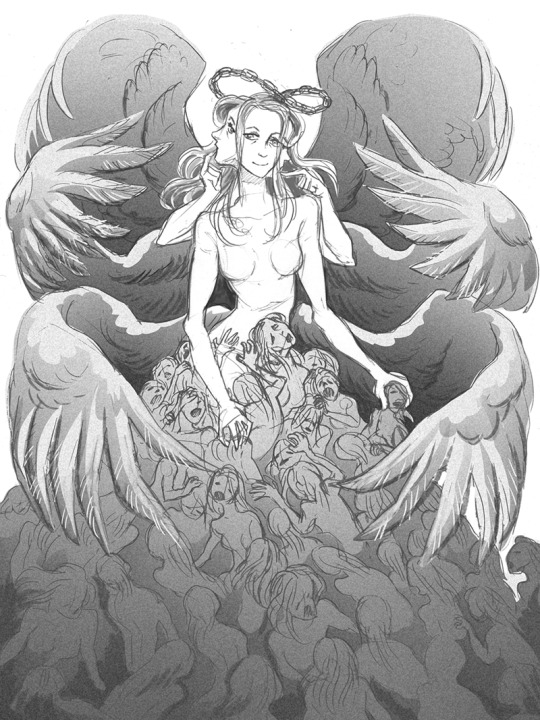
In the earliest stages of development, we toyed around with the concept of there being multiple "end game" forms of the Princess.
The initial outline, rather than being tied together by an overarching metanarrative, structured a full playthrough as a 5-6 chapter long, self-contained journey down a single route, determined by your decisions in chapter 1. Here's an alternative late-game form:

The idea of deviating end-game forms didn't lost for very long, though. As we explored the game's themes more deeply, it made the most sense for there to be a singular "true" form.
If your reality is shaped by subjectivity and perception, then the "truth" has to be what's left when that subjectivity is swept away. the Shifting Mound's final design feels like that initial truth for the Princess, though there's also another truth if you push back against her and press on into the final cabin.
We really liked this "void" design, and I played around with the idea of it being an intermediary to the final form. The "void" Princess would be what you saw upon encountering the final Princess without understanding your own truth, but once you had that understanding, you would see her as the Shifting Mound, as depicted in the game.
That gave way to the intermediary design of the SM being a sea of disembodied limbs, and we also took parts of both designs and incorporated them into the protagonist (particularly the wings.) You can see the eyes and feathers for this void form in the ending card of the original trailer below:

You can see extremely early concept art for the spectre (top), nightmare (top-right), stranger (left), beast (bottom) and ??? (right) as well!
The eyes became a motif in the Nightmare route (Paranoid's manifestation of the fear of being watched), but I also like to think of them as a part of The Long Quiet's truth. You are space and emptiness, but you're also that which observes those things, and it's your perceptions that give the Shifting Mound shape.

Anyways, on the note of the original original concepts for the game, the Princess was initially going to remain human for several loops before taking on more monstrous forms. Some concepts of that are below. Had to get Abby to tone down some of the more horrifically cartoonish designs because they creeped me out and I didn't want to romance them in a video game.
We had to hold our cards close to our chest in the non-metanarrative early drafts, which is part of why, even in the first demo, the cabin doesn't really change much in chapter 2. More room to subtly play with the concept of transformation over time.
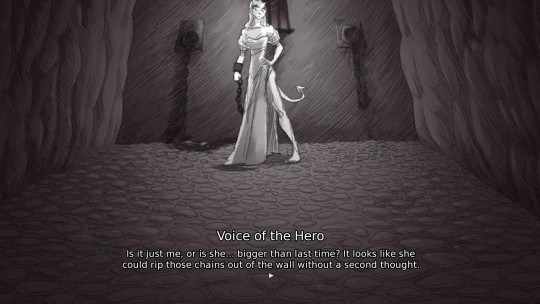
There were a lot of reasons we moved in a different direction for the full release. The branching was unmanageably large to write, and the game felt like a slog to write.
Using an overarching narrative as a framing mechanism in the final version gave us a lot more freedom to explore wildly divergent ideas within routes while still driving the player towards the originally planned finale.
Anyways, now we've got some concept art for individual princesses. There's a lot more than this lying around somewhere, but it's all in sketchbooks, and we'll probably wait until we make an art book to show it off.
First is the tower, who really didn't change much at all. (She got a little thicker, I guess. All of the Princesses did)
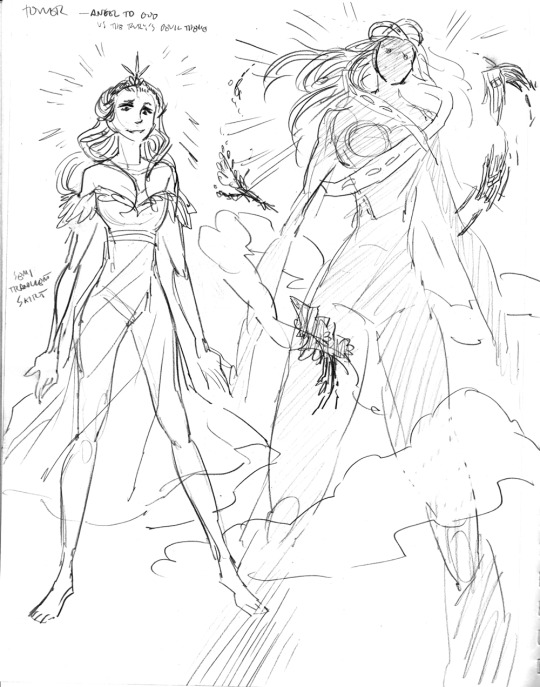

Not a lot to say about her, other than the fact that we knew we wanted a set piece where she gets so big that the trees and cabin orbit around her.
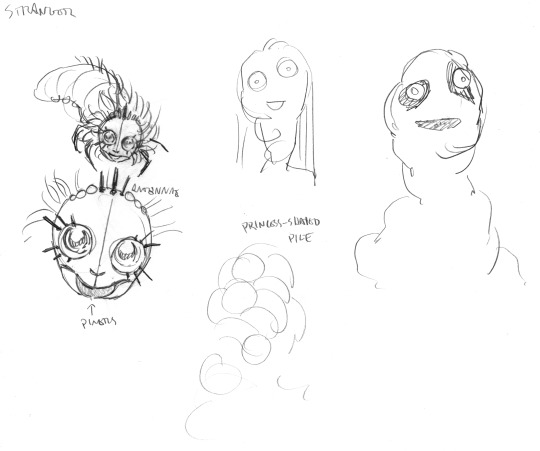
The stranger went through many many redesigns over the course of development. Here, she was a "princess skin" filled with a hive of sentient bugs. The script wasn't working for me, though, so instead she became a peak behind the curtains without the necessary context to know her.
A lot of people ask how these earlier drafts of the Stranger route would have played out, and the answer is I can't tell you, because I couldn't figure out something worth writing.
The writing process for individual routes didn't really start with outlines or plot beats. Rather, the routes started from a theme and a relationship dynamic, and I organically found their outcomes by exploring actions within those themes, and then seeing if those passed Abby's editor brain.
Neither of us found actions we wanted to explore with those versions of the Stranger, at least actions that weren't a beat-by-beat retelling of chapter 1, which contained way too much variation to put on a single chapter 2 route.
If each princess examines a relationship formed by perception and first impressions, the Stranger examines one that's fundamentally unknowable. One where you've seen too much, too quickly.
An insect hive-mind pretending to be a person seemed like a good starting point, but it was too difficult to write any interactions that didn't immediately feel knowable, if still strange. So the final version of the Stranger was designed in such a way where her unknowability makes interacting with her on a human level fundamentally impossible, and you don't get to have a real conversation with her unless you satisfy extremely specific criteria.
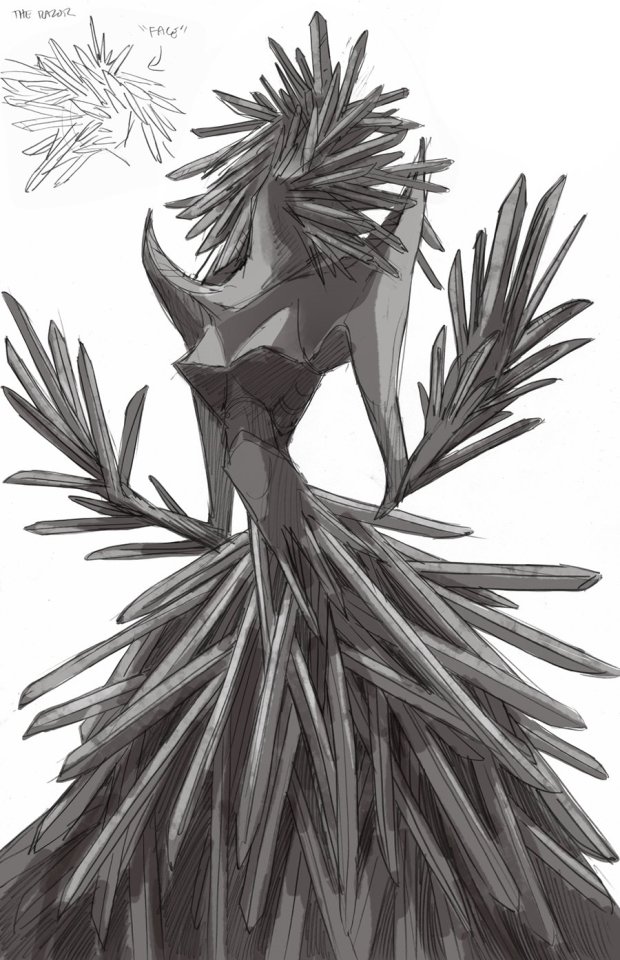
Anyways next up is the razor's final form. We decided she needed more swords.
Hearts became an accidental motif very quickly in the development process, too. (The fact that it is only strikes to the heart that fell her in the demo was accidental, but it felt poetic so we extended it to the rest of the game.)
So on top of adding more swords, we made her heart visible. This is something we did with the fury as well, as a way of showing their emotional (and physical) vulnerability.
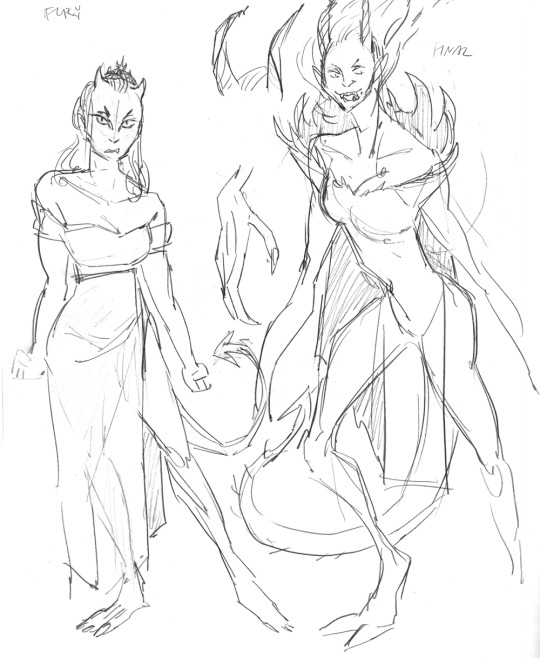
Here's an early version of the Adversary and what would eventually become the Eye of the Needle, back when she was still called the Fury. Originally her hair was going to be fire (as seen on the right), but it didn't feel right in its execution.
She's hit the gym since this concept art. Good for her :)

And we're going to end with the Beast, who at this point was called the Adversary. I think this was before the Witch was added? The Beast was originally designed to be a Questing Beast who lurked in the shadows, where you'd only see glimpses of her, and where each glimpse would make her appear to be a different animal. This was too difficult to execute, though we gave her a more chimera-like appearance in the final game.
This design was from when we still has the Voice of the Obsessed, and the route was going to be a more feral mirror of what eventually became the Adversary, but it felt too thematically similar while being less interesting, so we moved in the direction of making the Beast about consumption as a form of love.
Anyways, that's all we've got for you right now. Hope this was fun!
4K notes
·
View notes
Text
apollo cabin headcanons

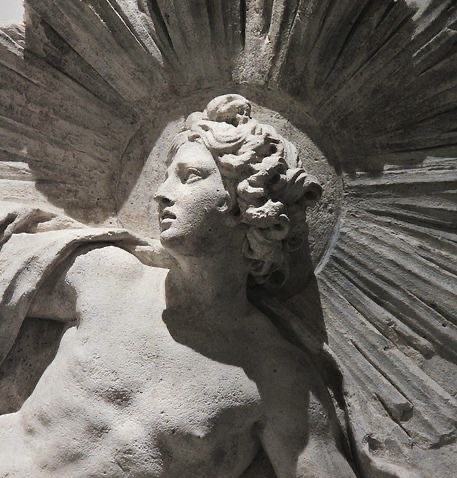

children of apollo
• apollo claims his children with a radiant golden aura with "we will rock you" playing triumphantly in the background.
• they are all born with a golden ring around the iris of their eye.
• many, if not all of them are born around sunrise and die around sunset.
• whenever there's a day that the sun isn't shining, it means a child of apollo has died and the sun god is mourning them.
• sometimes, someone will sing a random note, and then everyone around them will harmonize with them.
• the infirmary is always so HECTIC. like they all have insanely good accuracy so they’re just constantly throwing medical supplies at each other.
• they’re experts at hiding earbuds under their clothes so that teachers don’t see them.
• they’re all really sensitive to sounds. every tune that is off-key is the equivalent of a fork scrapping against a plate.
• their adhd is worse than most demigods because they can’t stand silence. long testing periods where you have to be silent are absolute torture for them.
• they all have some form of synesthesia.
• it’s harder for them to get sick compared to other demigods but when they do, it’s a mess. they take a lot longer to recover from the sickness.
• they’re always awake at the crack ass of dawn. not because they’re the children of apollo, but because apollo plays loud rock music every morning at a frequency that only his kids can hear.
• they’re basically roosters.
• they all have perfect pitch (they can tell what a note is just by hearing it).
• not all of them are good healers but there are certain times when it is mandatory for all children of apollo to be working in the infirmary.
• these times are mostly during and after war, an outbreak of a highly contagious disease, or after a particularly violent game of capture the flag.
• those who can't heal cut bandages, hand things to their siblings, and comfort scared patients.
• during the winter they always have the feeling of the warm sun shining on their skin even if it isn't there.
• as cool as they try to act, they are all shakespeare enthusiasts and can't help but quote it if you get them started.
• twins are common in the cabin since it sort of runs in the family.
• they’re ready for a musical number at any time. like one of them can yell the first note of a song and everyone else will join in.
• because artemis has her hunters, apollo tends to have more sons than daughters (it evens things out). when a daughter of apollo arrives to camp, her brothers are super overprotective over her.
• they’re known for replying to things with song lyrics.
• those who are musically inclined had formed an acapella group called the acapollos.
• they are completely terrified of the dark, due to their father being the god of light.
• they don't hate the dark itself— they're afraid of what they can't see, resulting in each of them having night lights above their beds. these night lights are shaped like the sun.
• they tend to glow when they’re near their crush or favorite person. the stronger the feelings are, the brighter the light is.
• they have secret late night jam sessions with lyres, pan flutes, and tambourines that can go all night. apollo listens in with a magic radio whenever they happen.



cabin exterior
• the cabin is bathed in a soft, golden glow, reminiscent of sunlight. this effect is most pronounced at sunrise and sunset, symbolizing apollo's dominion over the sun.
• the walls are adorned with intricate sun motifs and celestial designs, depicting various phases of the sun, stars, and constellations.
• musical notes and lyres are carved into the woodwork, reflecting apollo's role as the god of music. wind chimes made of delicate metals hang from the eaves, creating a harmonious melody when the breeze blows.
• quivers of arrows and archery targets are prominently displayed around the exterior.
• golden and yellow flowering vines, such as sunflowers and marigolds, climb the cabin walls, adding a natural touch and symbolizing the sun's life-giving energy.
• the architecture features clean lines and an open, airy design, with large windows to let in plenty of sunlight, creating a bright and welcoming atmosphere.
• one wall is dedicated to a mural depicting scenes of various prophecies, showcasing apollo's gift of foresight. the mural changes and updates itself magically as new prophecies are made.


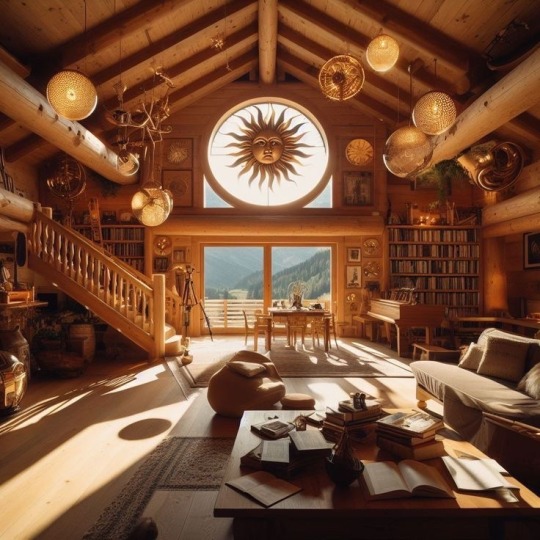
cabin interior
• various musical instruments, such as lyres, guitars, and harps, are scattered around the cabin. there are also dedicated spaces for practice and impromptu jam sessions, complete with sheet music stands and comfortable seating.
• the walls are adorned with paintings and murals created by the campers. these artworks depict scenes from mythology, portraits of famous musicians, and abstract representations of music and light.
• the interior decor uses a warm color palette of golds, yellows, and oranges, creating a sunny and cheerful ambiance. the furnishings are made of light-colored woods, adding to the bright and airy feel.
• one wall is dedicated to a large blackboard or whiteboard where campers can jot down lyrics, poems, and song ideas. this serves as a collaborative space for creativity and inspiration.
• several small, soundproof practice rooms are available for campers to practice their instruments, sing, or record music without disturbing others.
• a corner of the cabin is dedicated to repairing and maintaining musical instruments. it is equipped with tools, spare parts, and workbenches for campers who enjoy the technical side of music.
• the cabin is designed with excellent acoustics, ensuring that music sounds rich and vibrant. this makes the entire cabin feel like a resonant chamber, enhancing the musical experience.

cabin traditions
• on the winter solstice, they stay up all night so they can see their dad and all celebrate by saying "welcome back!"
• they have a weekly archery challenges among themselves with rotating themes, like shooting while blindfolded, hitting moving targets, or shooting from unconventional angles.
• they have an annual slam poetry competition in june when everyone is back at camp.
• the cabin regularly holds workshops on different aspects of healing, from herbal remedies to more magical techniques. they often team up with the demeter cabin for plant-based healing knowledge.
• they organizes an annual talent show open to all campers. it’s a fun, light-hearted competition where everyone can showcase their skills, whether it's music, archery, healing, or something completely unexpected.
divider by @samspenandsword
#percy jackson and the olympians#heroes of olympus#pjo#hoo#pjo hoo toa#pjo fandom#hoo fandom#pjo series#hoo series#pjo tv show#pjo disney+#pjo cabins#lester papadopoulos#apollo#apollo cabin#cabin seven#cabin 7#children of apollo
243 notes
·
View notes
Note
hey!! i really love your posts and trust me when i say this but you're practically doing a work of charity by making all these synonym lists. 😩🫶
i was wondering if you could compile monument vocabulary. vocabulary to describe the intricate and exquisite designs inside historical buildings. tysm!
Some Historical Architecture & Interior Design Vocabulary
Acanthus Leaf - A leaf decoration often used on furniture, particularly on brackets and legs.
Acroterium - Originally an ornament on the roof corners of Greek temples. In classical furniture, similar ornaments applied to the top corners of secretaries, bookcases, highboys and other furniture.
Amorini - Cupid ornaments found on Italian Renaissance furniture.
Anthemion - A honeysuckle design from classical Greek decorative motifs. Term refers to any conventional flower or leaf design.
Antique - Could be anything ranging from a piece of furniture to art. The U.S. government considers any item over 100 years old to be an antique, whereas most collectors use 50 years as a benchmark.
Apothecary Chest - A low chest with small drawers that was originally used to store herbs for cooking and medicinal purposes.
Arabesque - Decorative scroll work or other intricate ornamentation consisting of foliage, vases, leaves and fruits, or fantastic human and animal figures.
Baroque - A highly ornate decorative style that originated in Italy in the 1600's. The style is characterized by irregular curves, twisted columns, elaborate scrolls and oversize moldings. The Italian equivalent of French "rococo".
Bibliotheque-Basse - A low cupboard with shelves for books. Doors are often of glass and sometimes fitted with grilles.
Bullate - Having the surface covered with irregular and slight elevations, giving a blistered appearance.
Cabriole leg - An ornamented furniture leg with a double curve structure.
Chevron - A 'zigzag' pattern characteristic of Romanesque decoration that is often carved around pillars, arches and doorways.
Chinoiserie - A European style of design that is meant to mimic elements of East Asian art.
Console table - A freestanding table, often found in the entryway of homes, that typically serves as a space for decorative elements.
Enfilade - A series of rooms that are connected via doorways that align with one another (commonplace in grand castles, like the Palace of Versailles, or even museums).
Etagere - A freestanding or hanging set of open shelves, designed to display trinkets or other decorative objects.
Gilding - A coating with a thin layer of gold or gold-like substance.
Klismos - Ancient Greek style of chair with saber shaped legs splayed at the front and back. The back legs continue up to support a shoulder-height curved back.
Laurelling - A decorative feature using the laurel leaf motif as its basis.
Lozenge - A diamond shaped decorative panel. Term comes from the Middle English word for stone.
Niche - A recess in a wall for displaying a sculpture or other accessory.
Ormulu - A metal resembling gold. Used as mounts and decorative effects on furniture.
Ovolo - A continuous ornament in the form of an egg which generally decorates the molding called the "quarter-round". Eggs are often separated from each other by pointed darts.
Passementerie - Fancy decorative trimmings such as tassels, tiebacks and ribbon.
Régence Style - This furniture style spanned from about 1715 to 1723, when France was ruled by a regent. This style of furniture design was a transition from massive straight lines to graceful curves.
Sconces - A type of light fixture that is fastened to a wall for support.
Swan-Neck Handle - A curved handle popular in the 1700's.
Trompe l’oeil - A technique used to trick the eye into thinking that something flat, like a wall, is actually three-dimensional. This is often achieved through photorealistic painting.
Victorian - An architectural style defined by highly ornamented design and grand, sweeping facades.
Wainscoting - A type of interior wall paneling that covers the lower portion of a wall.
"Traditional" Interior Design
When talking about traditional interior design, most are referencing a design style that originated in the 18th and 19th century throughout Europe. However, it’s worth noting that other cultures have their own versions of a traditional style that may not look the same as this more Western version.
Traditional Design Elements. Though not exhaustive, a traditional interior will often make use of the following elements:
Emphasis on symmetry and order
Traditional architectural details such wainscoting and crown molding
Classic decor elements such as chandeliers and bookcases
Neutral color schemes with pops of bold colors, often in jewel tones
Upholstery and textiles tend to be subtler (cotton, velvet, or wool, for example)
Furniture pieces with traditional silhouettes, though they’re often updated with modern elements or finishes
Layered window treatments and draperies; curtain valances aren’t used often
Classic patterns such as plaids, damask, or florals
Flooring tends to make use of darker wood
Sources: 1 2 3 4 ⚜ More: Notes & References ⚜ Word Lists
Previous posts that include some related words you might find useful:
Some Architecture Vocabulary
Some European Renaissance Art Vocabulary
Some Medieval Art & Architecture Vocabulary: Part 1
Some Medieval Art & Architecture Vocabulary: Part 2
Some Roman Art Vocabulary
Thanks so much for your kind words, you're really sweet! I tried to include a wide range of terminology since you didn't specify which time period you were looking for. Do go through the sources if I wasn't able to include here what you need in your writing. Hope this helps <3
#terminology#architecture#interior design#writing reference#writeblr#dark academia#spilled ink#literature#writers on tumblr#writing prompt#writing inspiration#history#writing ideas#creative writing#writing resources
69 notes
·
View notes
Note
What's OSR? I've seen you mention it several times in your RPG posts. Is it like a genre of rpg or...?
Hey, sorry I took so long to reply to this lol you probably already just googled it by now.
But like. Anyway.
OSR (Old-School Revival, Old-School Renaissance, and more uncommonly Old-School Rules or Old-School Revolution, no one can really agree on what the R means) is less like a genre and more like a movement or a loosely connected community that seeks to capture the tone, feel and/or playstyle of 70's and 80's fantasy roleplaying games (with a particular emphasis on old-school editions of Dungeons and Dragons, particularly the Basic D&D line but pretty much anything before 3e falls under this umbrella), or at least an idealized version of what people remember those games felt like to play.
There isn't exactly a consensus on what makes a game OSR but here's my personal list of things that I find to be common motifs in OSR game design and GM philosophy. Not every game in the movement features all of these things, but must certainly feature a few of them.
Rulings over rules: most OSR games lack mechanically codified rules for a lot of the actions that in modern D&D (and games influenced by it) would be covered by a skill system. Rather that try to have rules applicable for every situation, these games often have somewhat barebones rules, with the expectation that when a player tries to do something not covered by them the GM will have to make a ruling about it or negotiate a dice roll that feels fair (a common resolution system for this type of situation is d20 roll-under vs a stat that feels relevant, a d6 roll with x-in-6 chance to succeed, or just adjudicating the outcome based on how the player describes their actions)
"The solution is not on your character sheet": Related to the point above, the lack of character skills means that very few problems can be solved by saying "I roll [skill]". E.g. Looking for traps in an OSR game will look less like "I rolled 18 on my perception check" and more like "I poke the flagstones ahead with a stick to check if they're pressure plates" with maybe the GM asking for a roll or a saving throw if you do end up triggering a trap.
High lethality: Characters are squishy, and generally die much more easily. But conversely, character creation is often very quick, so if your character dies you can usually be playing again in minutes as long as there's a decent chance to integrate your new PC into the game.
Lack of emphasis on encounter balance: It's not uncommon for the PCs to find themselves way out of their depth, with encounters where they're almost guaranteed to lose unless they run away or find a creative way to stack the deck in their favor.
Combat as a failure state: Due to the two points above, not every encounter is meant to be fought, as doing so is generally not worth the risk and likely to end up badly. Players a generally better off finding ways to circumvent encounters through sneaking around them, outsmarting them, or out-maneauvering them, fighting only when there's no other option or when they've taken steps to make sure the battle is fought on their terms (e.g. luring enemies into traps or environmental hazards, stuff like that)
Emphasis on inventory and items: As skills, class features and character builds are less significant than in modern D&D (or sometimes outright nonexistent), a large part of the way the players engage with the world instead revolves around what they carry and how they use it. A lot of these games have you randomly roll your starting inventory, and often this will become as much a significant part of your character as your class is, even with seemingly useless clutter items. E.g. a hand mirror can become an invaluable tool for peeping around corners and doorways. This kind of gameplay techncially possible on modern D&D but in OSR games it's often vital.
Gold for XP: somewhat related to the above, in many of these games your XP will be determined by how much treasure you gather, casting players in the role and mindset of trasure hutners, grave robbers, etc.
Situations, not plots: This is more of a GM culture thing than an intrinsic feature of the games, but OSR campaigns will often eschew the long-form GM-authored Epic narrative that has become the norm since the late AD&D 2e era, in favor of a more sandbox-y "here's an initial situation, it's up to you what you do with it" style. This means that you probably won't be getting elaborate scenes plotted out sessions in advance to tie into your backstory and character arc, but it also means increased player agency, casting the GM in the role of less of a plot writer or narrator and more of a referee.
Like I said, these are not universal, and a lot of games that fall under the OSR umbrella will eschew some or most of these (it's very common for a lot of games to drop the gold-for-xp thing in favor of a different reawrd structure), but IMO they're a good baseline for understanding common features of the movement as a whole.
Of course, the OSR movement covers A LOT of different games, which I'd classify in the following categories by how much they deviate from their source of inspiration:
Retroclones are basically recreations of the ruleset of older D&D editions but without the D&D trademark, sometimes with a new coat of paint. E.g. OSRIC and For Gold and Glory are clones of AD&D (1e and 2e respectively); Whitebox and Fantastic Medieval Campaigns are recreations of the original 1974 white box D&D release; Old School Essentials, Basic Fantasy and Labyrinth Lord are clones of the 1981 B/X D&D set. Some of these recreate the original rules as-is, editing the text or reorganizing the information to be clearer but otherwise leaving the meachnics unchanged, while others will make slight rules changes to remove quirks that have come to be considered annoying in hindsight, some of them might mix and match features from different editions, but otherwise they're mostly straight up recreations of old-school D&D releases.
There are games that I would call "old-school compatible", that feature significant enough mechanical changes from old-school D&D to be considered a different game, but try to maintain mechanical compatibility with materials made for it. Games like The Black Hack, Knave, Macchiato Monsters, Dungeon Reavers, Whitehack, etc. play very differently from old-school D&D, and from each other, but you generally can grab any module made for any pre-3e D&D edition and run it with any of them with very little to no effort needed in conversion.
There's a third category that I wouldn't know how to call. Some people call then Nu-OSR or NSR (short for New School revolution) while a small minority of people argue that they aren't really part of the OSR movement but instead their own thing. I've personally taken to calling them "Old School Baroque". These are games that try to replicate different aspects of the tone and feel of old-school fantasy roleplaying games while borrowing few to none mechanics from them and not making any particular attempts to be mechanically compatible. Games like Into the Odd, Mörk Borg, Troika!, a dungeon game, FLEE, DURF, Songbirds, Mausritter, bastards, Cairn, Sledgehammer, and too many more to name. In my opinion this subsection of the OSR space is where it gets interesting, as there's so many different ways people try to recreate that old-school flavor with different mechanics.
(Of course, not everything fits neatly into these, e.g. I would consider stuff like Dungeon Crawl Classics to be somewhere inbetween category 1 and 2, and stuff like GloG or RELIC to be somewhere imbetween categories 2 and 3)
The OSR movement does have its ugly side, as it's to be expected by the fact that a huge part of the driving force behind it is nostalgia. Some people might be in it because it harkens back to a spirit of DIY and player agency that has been lost in traditional fantasy roleplaying games, but it's udneniable that some people are also in it because for them it harkens back to a time before "D&D went woke" when tabletop roleplaying was considered a hobby primarily for and by white men. That being said... generally those types of guys keep to themselves in their own little circlejerk, and it's pretty easy to find OSR spaces that are progressive and have a sinificant number of queer, POC, and marginalized creators.
225 notes
·
View notes
Text
I cannot emphasize enough that Rouge was NOT introduced as a flirt, femme fatale, or any other type of seductress. She has never once used her "feminine charms" for anything in ANY mainline game where she has a relevant role.
But because she started being mischaracterized so much earlier than the others, in 2003's Sonic X, it's become so normalized that nobody even questions it like they do with everyone else and I for one am tired of it
And honestly, I'd argue that half the appeal of her character was that she didn't rely on her appearance to get things done, despite ostensibly being able to by virtue of how she's designed. When she strikes a deal with Eggman and Shadow, it has nothing to do with how hot she supposedly is - it's entirely about her competence as a treasure hunter.
Even her romantically-coded scenes with Knuckles were never about him being flustered by her appearance, or any advances she was making. They kinda just bicker like any other pair of characters would, and the romantic aspect is fairly downplayed.
And she's not a character who's particularly bound by romance, either; her actual most important relationship, with Shadow, is shown to be solely platonic and way more die-hard than whatever she has going on with Knuckles.
Which is interesting! How often do you have a character who's a ~secret spy~ designed to be attractive and alluring, with heart motifs all over her, who isn't just Not A Seductress, but is actively more engaged with her best friend than her prospective love interest? It's cool! I want more of that!
In conclusion, Rouge the Bat is awesome and deserves better than to have her original personality completely tossed to the wayside without people even noticing
#sonic the hedgehog#rouge the bat#analysis#meta#I don't mean to throw Omega under the bus here but he and Rouge never really got one-on-one bonding time#so her friendship with Shadow is still more important narratively#Anyway if I have to hear Rouge refer to someone as 'sugar' one more time I'm gonna lose it#THAT'S NOT HER THING THAT HAS NEVER BEEN HER THING
82 notes
·
View notes
Photo

Mycenaean Pottery
The pottery of the Mycenaean civilization (1550-1050 BCE), although heavily influenced by the earlier Minoans based on Crete, nevertheless, added new pottery shapes to the existing range and achieved its own distinctive decorative style which was strikingly homogenous across Mycenaean Greece. Mycenaean wares typically display stylized representations of marine and plant life and show a fondness for minimalistic linear designs, a trend which would go on to influence the early pottery of Archaic and Classical Greece from the 9th century BCE.
Minoan Origins
Early wheel-made Mycenaean pottery (1550-1450 BCE) from mainland Greece has been described as 'provincial Cretan' which does convey the fact that although shapes and decorative styles were of Cretan origin, the final decoration was not quite as finely executed as in Minoan centres such as Knossos and Phaistos. However, despite this difference in quality, it is likely that Cretan potters did actually relocate to the mainland. In terms of raw material though, Mycenaean pottery is in fact often superior in quality to Minoan as the majority was made from old Yellow Minyan Clay and fired at higher temperatures than on Crete. The designs themselves were painted using a red to black, lustrous, iron-based clay slip (or 'paint') which had a tendency to become mottled depending on the firing process.
The Minoan love of flowing shapes and vibrant representations of animal, sea and plant life as expressed in their Marine and Floral styles was continued by the Mycenaeans with octopuses and nautiluses remaining particularly popular. Designs also continued to fill all of the decorative surface and follow the contours of the vessel. Gradually though, representations became more stylistic and more symmetrical with not all of the decorative space filled, leaving significant blanks, something rarely seen in Minoan pottery. Depictions of plants such as lilies, palms and ivy became more monumental, evolving into commonly employed motifs that were reserved principally for large jars.
From 1450 BCE the Mycenaean expansion overseas resulted in the taking over of the Cretan palaces and Mycenaean pottery began to dominate production across Greece and the Aegean islands. Indeed, pottery is the most important indicator we have of the political domination of the Mycenaeans across the Aegean. Decoration may be divided into two broad groups: the Pictorial style and the Pattern style. The former was influenced by contemporary fresco design and sought to represent scenes of daily life and the latter employed decorative scales, chevrons, and sea-life. Designs steadily became even bolder and more stylized, often with only a single motif design on each side of the vessel and an increase in the space left blank. Perhaps the most celebrated example of this minimalist style is the Ephyrean goblet, a stemmed, two-handled cup from Mycenae which is decorated with a single large rosette on each face. Plain, bold horizontal lines and whorls continue to be very popular forms of decoration and are usually well-chosen to complement the shape of the vessel.
Continue reading...
48 notes
·
View notes
Note
have you written anything about tattoos? is that relevant? don't know how your niche lines up with generic "sailor" tradition, but wikipedia simply says on knuckle tats that deckhands may get "HOLD / FAST" as a charm to support their grip on rigging, and i thought that was kind of cute.
I haven't written anything myself, mostly cos if you throw a stick out in the internet you'll find any number of articles about the symbolism of sailor tattoos, like hold fast and pigs and roosters and swallows and all that!
In my narrow window (the middle decades of the 19th century), I don't see tattoos mentioned all too often, compared to late 19th and throughout the 20th century where they became more common. For instance, this register of seaman's protection certificates (which are admittedly limited in the scope of things, since they're only from a few specific ports) from 1796-1871 rarely list tattoos as distinguishing marks, beyond the odd mention of being marked with an inked anchor, eagle, or letters here or there. Here's a neat jstor article (if you have any more of your 100 free monthly articles to read with a google account) that goes into late 18th-early 19th c tattoos that has some tables and visuals. The research was also done using seaman's protection certificates, with the following stat:
"The SPC-A records start in 1796 and include tattooed men born as early as 1746. There were 979 tattooed men out of a total of 9,772 men whose records survive from 1796 through 1818.26 These men were marked with a total of about 2,354 separate designs."
So, not a large number, but also 10% isn't insignificant. The protection certificates while a reliable source, also only describe the man in one specific moment. I'm sure a few of those men who just have their moles and scars and crooked fingers listed eventually picked up a tattoo or two in their time. Most journal keepers perhaps didn't think it important to mention who had tattoos or what of, though the typical motifs of anchors, nautical stars, girls, religious & patriotic imagery, etc. were certainly a part of the visual language at this point. Whaler William Abbe who sailed in the 1850s, devoted considerable attention to describing the physical appearance of some of his shipmates. In one instance, he wrote about the tattoos of one 'Johnny Come Lately' or 'Jack Marlinspike' (Real name, John Hewes of Buffalo NY)
'from beneath this cap his face looms out - while beneath supporting his comical head is a bare neck and breast — hairy + brown —the upper timbers to a stout hull of a boat that boast a pair of arms all covered with India ink tattooings — the figure of American Liberty — Christ on the cross — an American Tar holding a star spangled banner in one hand + a coil of rope in the other — a fancy girl — + anchors, rings, crosses, knots, stars all over his wrists + hands — the memorials of different ports he has visited — for Jack has been in all kinds of vessels from a man of war to a blubber hunter — + has consequently been to many ports.'
From the logbook of another whaler who sailed in the early 1840s, James Moore Ritchie, he had a page of his drawings with prices included. This potentially may have been a tattoo flash sheet for his shipmates:
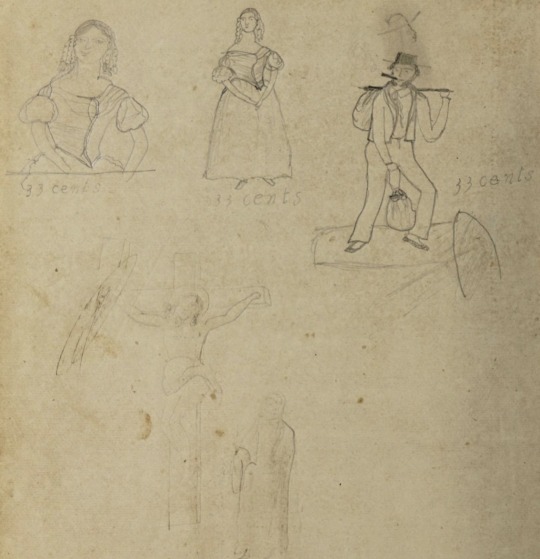
American whalers also noted the tattoos of indigenous people who had signed on to whaling vessels, particularly in the South Pacific. William B. Whitecar, whaling in the 1850s wrote: "Several New Zealanders in the respective crews of these vessels attracted my attention from the tattooing on their bodies" making mention of "figures on their face and breast".
I'm too sleepy to have a conclusion lol. Tattoos! They existed! Though perhaps not as ubiquitously as the pop culture sailor designs would imply, at least prior to the late 19th c.
222 notes
·
View notes
Text
Character inspiration meme!

[tagged: not tagged, saw people doing this on dash again since I follow lots of roleplay blogs haha decided to do this for my only proper OC]
[tagging: @ambalambs , @hexenjagd , @cursedfortune , @rostomanologist , @commander-wame , @missbadafker (for any of your characters!), @lyhil , @harukehn (hii I like your plants... I am tagging you both if that's okay :) @scribesofcalamity I want! 👏 to know 👏 the cool inspos!!! Also I'd tag all the pretty plants in the fandom but I'm not sure who likes dash games ^^, so if you see this and feel like doing it, you're ON! Feel free to say I tagged you!]
Also you know I had to do it to him (choose this as his profile picture)
Anyway! Explanations go:

1 - Bloodborne - Lady Maria of the Astral Clocktower - largely self-explanatory. I would have exchanged her for Genshin's Raiden Shogun for the more accurate "draws swords from own body" visual, BUT the fun part is I actually didn't know she did that. So the Baal sword and Mael's solid shadow weapons are a complete coincidence 💀
Furthermore, Lady Maria's general aesthetic influenced my own design a good deal. Sadly, necromancers can't wear medium armor.
2 - Hollow Knight - God of Gods/Shade Lord - just the vibes for his Shroud... or is it something more? :P I guess we shall see once I iron out some plot points. Some people might know because I rant in DMs. Devouring darkness my beloved. Inspiration for a potential "corrupted form" for a fractal where the story went really wrong.
3 - Norse Mythology - Fenrir - core inspiration. Chain/binding motif, being something dangerous, even to gods. Power that needs suppressing. Everlasting hunger, being the doomed being with the potential to doom others in return. A... specific relationship with the sun. A certain someone losing a hand within the mouth of the beast.
His swords are named Dromi and Lædingr after the first two chains that bound Fenrir. He's currently looking for a way to devise a "perfect spell" to allow complete control over his volatile magic and stop the demon essence from further warping his body and affecting his mind - that spell, or perhaps item, being Gleipnir.
4 - Tower of God - Khun Aguero Agnes - personality and mannerisms inspiration, particularly post-The Departing. "The Commander when he locks the fuck in." Devilishly intelligent and not afraid to utilize underhanded methods, but ultimately a good person. A true silver tongue. Moderately to severely grumpy at times. Dramatic flair. Gay boy rizz.
5 - Kabaneri of the Iron Fortress - Ikoma - the survivor. Undead but won't take the L and keeps on going no matter what. Self-engineered restraints to keep his affliction under control, dog motif, being willing to do terrible things to his own body simply to stop himself becoming a monster. A heart replaced by a core.
6 - Legend of Vox Machina - Percy de Rolo - I have actually not watched this show yet (I really damn need to) the visuals, the gunplay, the demonic possession and those deep black eyes with yellow irises? Checks out. I made Mael in 2014, so, again, coincidence, but it's a really good-looking coincidence :-)
Also, template below cut!

34 notes
·
View notes
Text
The Backless Revelation
We Miss You sequel (2)
--
Esteban Ocon x Pierre Gasly x Charles Leclerc | 1.3K
--

Esteban wasn’t sure what had possessed him to agree to this. Maybe it was the earnest sparkle in Erina’s eyes when she’d asked him to model for her fashion design project. Or maybe it was the fact that he’d known her for years—she was his neighbor’s daughter, a sweet, determined fashion student with a dream of making it big in haute couture.
“Please, Esteban,” Erina had begged, clutching her sketchpad like it was her lifeline. “I just need one male model for my final collection. It’s bold and unconventional, but I think it’s perfect for you. You have the frame, the poise... and you’d look stunning.”
He’d laughed nervously at her passionate pitch, unsure of what he was signing up for. But Esteban was nothing if not a people-pleaser, and he didn’t have the heart to say no.
Now, standing in front of the camera in Erina’s tiny makeshift studio, he was starting to regret his decision.
“Trust me, Esteban,” Erina chirped as she adjusted the fabric of the suit, her fingers deftly arranging the black material over his shoulders. “You’re going to look amazing. This backless design is the centerpiece of my collection—it’s daring, elegant, and androgynous. It’s meant to break stereotypes.”
Esteban glanced over his shoulder at the mirror, taking in the plunging backline of the suit that left most of his spine exposed. A temporary tattoo—a delicate butterfly and rose motif—sat perfectly at the center of his back. It was bold, yes, but undeniably beautiful.
“Are you sure about this?” he asked, fidgeting slightly. “I mean, it’s... a bit much.”
Erina gave him an encouraging smile, her warm brown eyes filled with gratitude. “You’re perfect, Esteban. Just trust me, okay? And thank you so much for doing this—I owe you big time.”
Her sincerity melted his nerves a little, and he sighed, nodding. “Alright. Let’s do this.”
The photographer, a fellow student with a talent for capturing raw emotion, guided Esteban through the poses. Erina fussed over every detail, ensuring the suit draped just right and that the tattoo caught the light beautifully.
“Lift your chin a little,” the photographer directed. “Now turn your head slightly to the left... perfect. Hold that.”
Click. Click. Click.
As the shoot went on, Esteban found himself relaxing. The initial awkwardness faded, replaced by a quiet confidence he didn’t know he had. Erina’s energy was contagious—she radiated pride and excitement every time she looked at the shots on the camera screen.
“You’re killing it!” she exclaimed after a particularly striking shot. “You’re going to make my collection stand out at the showcase.”
By the end of the session, Esteban was actually smiling. Erina handed him a bottle of water and beamed up at him like he’d just won her an award.
“You were amazing,” she said, practically bouncing on her toes. “This is going to be the highlight of my portfolio. And don’t worry, I’ll make sure you get credit when it goes public.”
Esteban chuckled, ruffling her hair affectionately. “You’re the real star here, Erina. I just stood where you told me to.”
She shook her head fiercely. “No way. You brought my design to life. I’ll send you a copy of the magazine when it’s published, okay? Thank you again, Esteban. You’re the best.”
As he left the studio that evening, Esteban felt a strange mix of pride and trepidation. He couldn’t deny that the experience had been fun, but he also couldn’t shake the thought of how Pierre and Charles would react when they saw him in that backless suit.
Little did he know, their reactions would be far more dramatic than he anticipated; The morning started like any other in their home—a comfortable quiet broken only by the sound of birds outside and the faint hum of the coffee machine. Pierre was the first to stir, padding barefoot into the kitchen with his hair sticking up in every direction. Charles followed not long after, still rubbing the sleep from his eyes as he joined Pierre at the counter. As for Esteban, he was still asleep due to overtime at work, it seems the new project Alpine in seems to take more time than he expected.
Their peaceful routine was abruptly interrupted when Pierre’s gaze landed on something new resting on their coffee table. A glossy magazine sat there, slightly out of place among their usual stack of car and sports publications. The cover featured models in bold, modern designs, but what caught Pierre’s attention wasn’t the magazine itself—it was the image tucked inside.
“Charles,” Pierre called, voice sharp with intrigue. “Come look at this.”
Charles leaned over Pierre’s shoulder as he flipped open to a page bookmarked by chance. And there he was. Esteban. Their Esteban. In a sleek, black backless suit that hugged his slim frame perfectly. His back was exposed, highlighting the delicate arch of his posture, while a temporary tattoo—a striking design of a butterfly and rose—decorated the center of his spine.
The suit was bold, unconventional, and effortlessly elegant. His face was soft yet captivating, lips slightly parted, as though daring anyone to look away.
“Mon dieu…” Charles murmured, jaw dropping slightly. “That’s… our Esteban?”
Pierre couldn’t help but laugh, though it came out more breathless than amused. “Why didn’t he tell us he did this? Look at him! He’s a work of art.”
Esteban, of course, was still asleep upstairs, blissfully unaware of the effect his photo shoot had on his boyfriends. Charles immediately grabbed the magazine and started flipping through it for more pictures. Sure enough, there were a few pages dedicated to him—poses that showed off his lanky yet graceful frame, the elegance of his hands, and the soft tilt of his head.
They didn’t even bother finishing their coffee. Instead, they marched upstairs, the magazine in hand. Pierre was the first to push open the bedroom door, revealing Esteban still curled under the blankets, his hair a messy halo on the pillow.
“Esteban,” Charles called gently, his voice filled with a mixture of amusement and adoration. “Wake up.”
Esteban stirred, blinking up at them groggily. “What’s going on?” His voice was still thick with sleep, making him look even softer in their eyes.
“Oh, nothing,” Pierre said, smirking as he sat on the edge of the bed. He held up the magazine, flipping to the now-infamous page. “Care to explain this?”
It took a moment for Esteban’s sleep-addled brain to catch up. When his eyes focused on the image, his face turned scarlet. “Oh my god,” he groaned, burying his face in his hands, mumbling. “I forgot I put the magazine at the coffee table.”
Charles slid into the bed on the other side of him, pulling Esteban’s hands away from his face. “Forgot? How could you forget something like this? You’re stunning. Breathtaking. Look at you.”
Pierre leaned closer, his eyes gleaming with mischief. “You should’ve warned us, though. How are we supposed to focus on anything now?”
Esteban couldn’t find a way to defend himself. His heart was racing as Pierre and Charles took turns teasing him, flipping through the magazine to point out their favorite shots.
“You’re wearing our shirts for the next week,” Pierre finally declared, his hands tracing a path up Esteban’s arm. “No one else deserves to see you like this.”
Charles nodded, pressing a kiss to Esteban’s temple. “Agreed. We’re keeping you all to ourselves.”
They started showering him with kisses, soft and lingering, trailing from his cheeks to his forehead, and down to his lips. Esteban was quickly overwhelmed, his protests dissolving into quiet, breathless laughter as they cornered him in the bed.
“You’re ridiculous,” he finally managed to gasp, though the fondness in his tone was unmistakable.
Pierre grinned, his hand brushing a strand of hair away from Esteban’s forehead. “And you’re ours.”
As Esteban sank back into the pillows, utterly spoiled and glowing from their attention, he couldn’t help but think that he didn’t mind being their doll after all.
#pierre gasly#f1 imagine#f1#f1 fanfic#f1 fic#pierre x estaben#estaban ocon#pierre x estaben x charles#pierre x charles x estaben#pierre x charles#charles leclerc#pierresteban#f1 fiction
31 notes
·
View notes
Note
Imo there is not enough Valyria content out there so I would LOVE to see your thoughts/headcanons on what the geography, city, fashion, etc. looked like
okay this ones a little difficult because even though Valyria is clearly inspired by Rome, I don't like roman (aka greek) architecture for them it just doesn't really fit to me. Honestly its hard to assign any real life inspo because the existence of dragons would have had some major impact on the society as a whole, architecture included

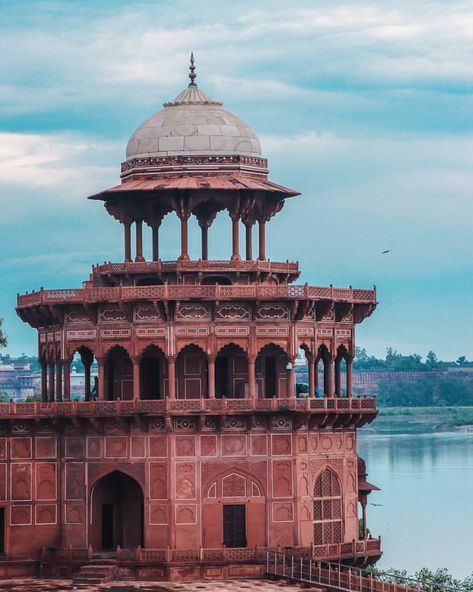


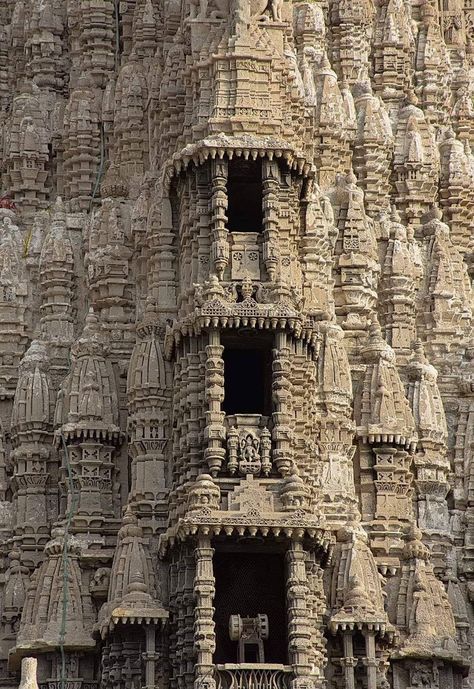
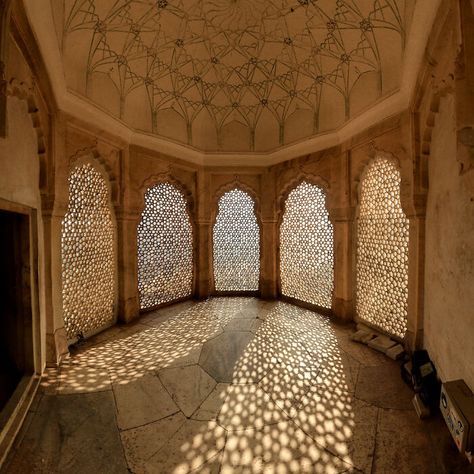
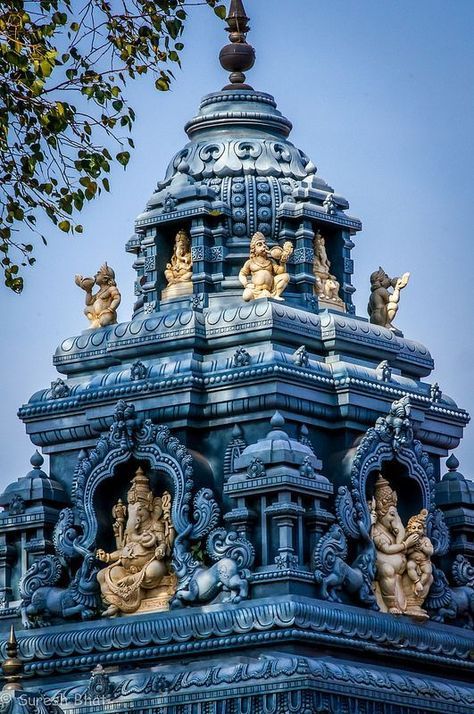

However, if I had to pick a type to ascribe to Old Valyria, my first choice would be a twist on Hindu architecture. I am absolutely obsessed with the sheer amount of details on the buildings (especially the Meenaskshi Temple at the bottom, everyone please go look at more pictures of it it's gorgeous). It's incredibly complex but also tends to be very symmetrical, the styles perfected over hundreds and hundreds of years. I also really love the idea of the spaces being open and well lit, it fits well.
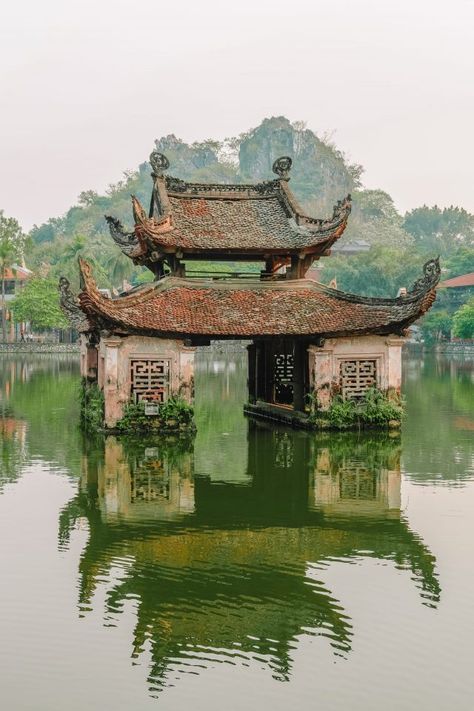
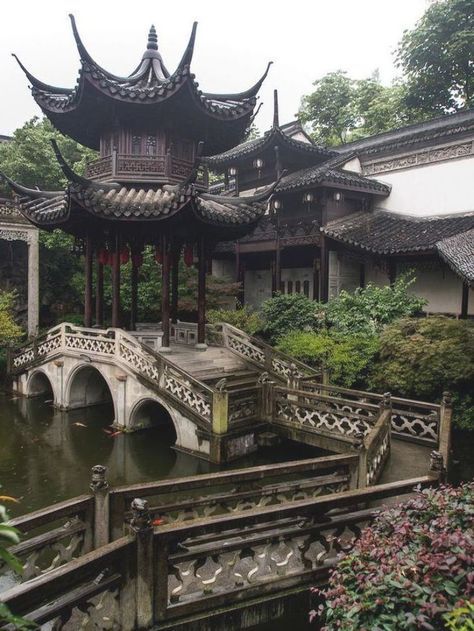

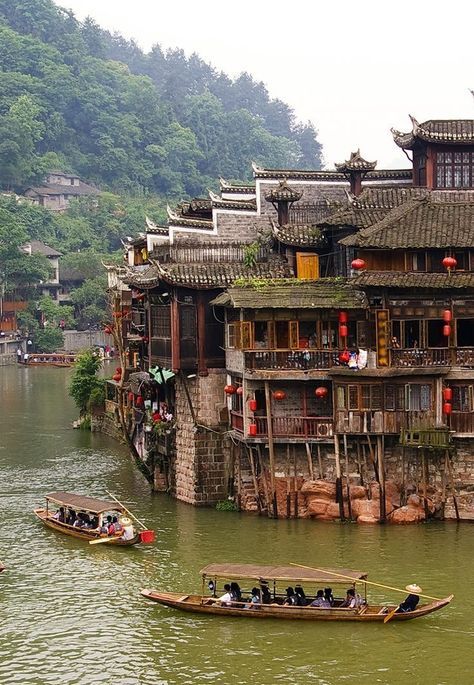

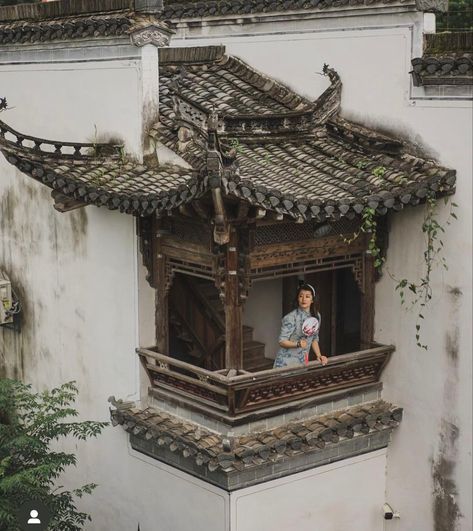
Another alternative is traditional Chinese architecture, with the added bonus of dragon motifs that are already there :D Another type of architecture with an intense focus on details, symmetry, and how the design of a space affects a person. Architecture is a reflection of where a society is in their development, and I find that this could be a good inspiration for Valyria, an advanced culture with the excess time and resources to build things like these.
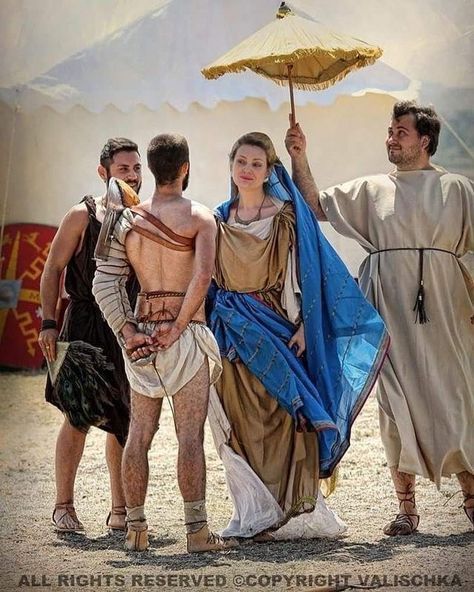

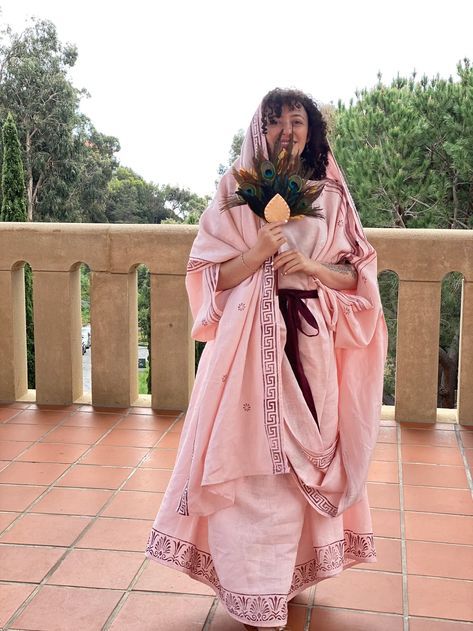

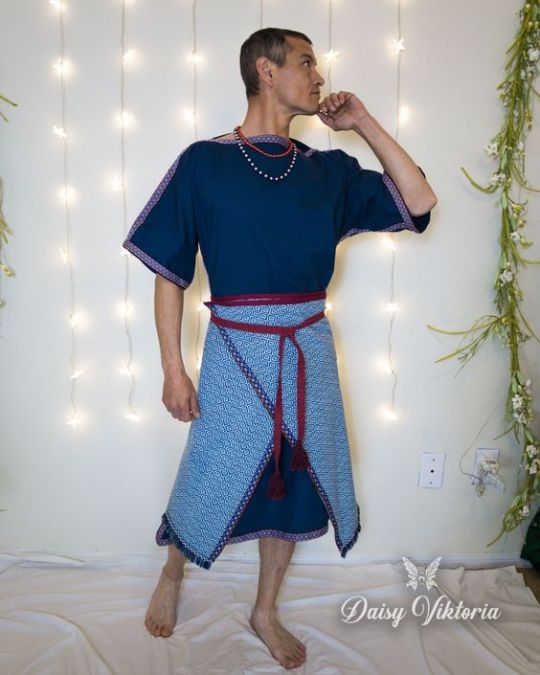


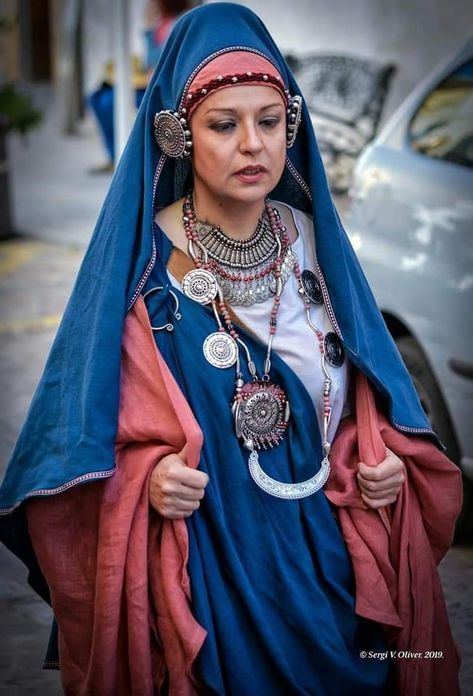
Woof okay clothing is all over the place I need to brainstorm and tighten my focus on different inspos (also I wish I could draw well so I can blend these styles properly but alas...anyways we ball). The main thing is mediterranean cultures I know that much. The Iberian Peninsula, Rome, Greece, the Minoans, Malta, Cyprus, etc etc all the ancient clothing and traditional costumes from around the Mediterranean Sea. Valyria was in a warmer, damper climate, meaning lots of loose fabric that could let air through but wouldn't weigh you down. Also doubling as shields from the sun. You get the gist I use this type of clothing all the time.
Okay Random Cultural Things Time
Art and literature? honestly really important because while yes this was a conquering civilization, they needed their exploits to live on in wall frescoes and written epics and dramatic pantomimes. I think they were literate, and probably spread written Valyrian to all the colonies, so that they were easily assimilated. People particularly fond of their dragons had pictures of them made and statues sculpted so that they would live on after their death.
Sports and entertainment also pretty big as well. Valyrians were a highly competitive people To Me so I think that riding, swimming, wrestling, racing, and other games were popular with the people, even those in the higher classes. Also fuck it I bet they raced their dragons. A really tall amphitheater where rich men lost money as they watched dragons circle around the ring. Or fight in midair, if the dragon riders were prisoners or sentenced to death.
As for religion, the Valyrians worshipped the gods that gave them dragons, but also tolerated the other faiths of the places the conquered, just in order to ease tensions (and because they had no dragons so why would they worship dragon gods). I like the idea of Roman household gods, with small altars in every home. Statues of the gods of the home, along with any gods a particular family might favor, along with ancestor veneration and dragon veneration. Dragon skulls and dragon masks on the walls baby!
#woah this was really long#spent my entire women and gender studies class doing this sorry Judith butler#asoiaf worldbuilding
93 notes
·
View notes
Text


The Green Man by Talon Abraxas
Symbol of life and nature:
The most common and perhaps obvious interpretation of the Green Man is that of a pagan nature spirit, a symbol of man’s reliance on and union with nature, a symbol of the underlying life-force, and of the renewed cycle of growth each spring. In this respect, it seems likely that he has evolved from older nature deities such as the Celtic Cernunnos and the Greek Pan and Dionysus.
Some have gone so far as to make the argument that the Green Man represents a male counterpart - or son or lover or guardian - to Gaia (or the Earth Mother, or Great Goddess), a figure which has appeared throughout history in almost all cultures. In the 16th Century Cathedral at St-Bertrand de Comminges in southern France, there is even an example of a representation of a winged Earth Mother apparently giving birth to a smiling Green Man.
Because by far the most common occurrences of the Green Man are stone and wood carvings in churches, chapels, abbeys and cathedrals in Europe (particularly in Britain and France), some have seen this as evidence of the vitality of pre-Christian traditions surviving alongside, and even within, the dominant Christian mainstream. Much has been made of the boldness with which the Green Man was exhibited in early Christian churches, often appearing over main doorways, and surprisingly often in close proximity to representations of the Christ figure.
Incorporating a Green Man into the design of a medieval church or cathedral may therefore be seen as a kind of small act of faith on the part of the carver that life and fresh crops will return to the soil each spring and that the harvest will be plentiful. Pre-Christian pagan traditions and superstitions, particularly those related to nature and trees, were still a significant influence in early medieval times, as exemplified by the planting of yew trees (a prominent pagan symbol) in churchyards, and the maintenance of ancient “sacred groves” of trees.
Tree worship goes back into the prehistory of many of the cultures that directly influenced the people of Western Europe, not least the Greco-Roman and the Celtic, which is no great surprise when one considers that much of the continent of Europe was covered with vast forests in antiquity. It is perhaps also understandable that there are concentrations of Green Men in the churches of regions where there were large stretches of relict forests in ancient times, such as in Devon and Somerset, Yorkshire and the Midlands in England. The human-like attributes of trees (trunk-body, branches-arms, twigs-fingers, sap-blood), as well as their strength, beauty and longevity, make them an obvious subject for ancient worship. The Green Man can be seen as a continuing symbol of such beliefs, in much the same way as the later May Day pageants of the Early Modern period, many of which were led by the related figure of Jack-in-the-Green.
Symbol of fertility:
Although the Green Man is most often associated with spring, May Day, etc, there are also several examples which exhibit a more autumnal cast to the figure. For example, some Green Men prominently incorporate pairs of acorns into their designs (there is a good example in King's College Chapel, Cambridge), a motif which clearly has no springtime associations. In the same way, hawthorn leaves frequently appear on English Green Men (such as the famous one at Sutton Benger), and they are often accompanied by autumn berries rather than spring flowers. The Green Man in the Chapelle de Bauffremont in Dijon (one of the few to retain its original paint coloration) shows quite clearly its leaves in their autumn colours.
This may have been simple artistic license. However, acorns, partly due to their shape, were also a common medieval fertility symbol, and hawthorn is another tree which was explicitly associated with sexuality, all of which perhaps suggests a stronger link with fertility, as well as with harvest-time.
Symbol of death and rebirth:
The disgorging Green Man, sprouting vegetation from his orifices, may also be seen as a memento mori, or a reminder of the death that await all men, as well as a Pagan representation of resurrection and rebirth, as new life naturally springs out of our human remains. The Greek and Roman god Dionysus/Bacchus, often suggested as an early precursor of the Green Man, was also associated with death and rebirth in his parallel guise as Okeanus.
Several of the ancient Celtic demigods, Bran the Blessed being one of the best known, become prophetic oracles once their heads had been cut off (another variant on the theme of death and resurrection) and, although these figures were not traditionally represented as decorated with leaves, there may be a link between them and the later stand-alone Green Man heads.
There are several examples of self-consciously skull-like Green Men, with vegetation sprouting from eye-sockets, although these are more likely to be found on tombstones than as decoration in churches (good examples can be seen at Shebbear and Black Torrington in Devon, England). Such images might be interpreted as either representing rebirth and resurrection (in that the new life is growing out of death), or they might represent death and corruption (with the leaves growing parasitically through the decaying body).
The Green Man as archetype:
The very fact that images of the Green Man have appeared historically in such disparate and apparently unconnected locations have led some commentators, notably Roweena Pattee Kryder and William Anderson, to suggest that the figure is part of our collective unconscious, and represents a primeval archetype (in Jungian parlance) which is central to our relationship with Nature.
Phyllis Araneo has suggested that the appearance of the Green Man in European and worldwide art is a cyclical phenomenon triggered by times of crisis or significant change. For example, she suggests the proliferation of Green Man imagery after the 11th Century can perhaps be associated with feelings of relief and celebration after the widely predicted apocalypse of the millennium failed to materialize.
In the same way, the modern resurgence may have been triggered by the environmental crisis we are currently living through. In its modern revival, in the wake of James Lovelock’s Gaia Hypothesis and the birth of the modern Green movement, the Green Man can be seen as the archetype of the “conservator”, whose brief is to counsel us to take from the environment only what we need to survive and to conserve the rest, and to remind us of our responsibilities for the stewardship of the natural world. A quote from Mike Harding succinctly summarizes this position: “If anything on this poisoned planet gives us hope of renewal it is this simple foliate head that has been there in one form or another since the beginning.”
-The Enigma of the Green Man - Theories and Interpretations
38 notes
·
View notes
Text
Hey so not to get too wildly off-track from the normal topic of conversation on this blog, but if you so permit it, I'd love to talk about another little theory of mine about the Magnus Protocol of all things. It's only a little hatchling, too young to really be too particular on the details, but we've got that season 2 drop closing in, so there's only so much time I have left to ship it off before it gets completely demolished from being proven wrong 6 times over.
As you might expect, spoilers incoming for pretty much the entirety of Season 1 (Not including the s1 epilogue).
So, the fears, right? If you've not heard of them, then you are the very rare individual that has somehow both found my blog, and listened to the entirety of Magnus Protocol before listening to half of Magnus Archives. I am very proud of you for managing to find this; though perhaps you should check if you've been marked by the Eye. (Joking.)
We're here to get down to the fears, where are they now, what's their new business plan, etc. etc. Well, I can say one thing for certain: Smirke's 14 is certainly not the main system we're operating with. There are some clear remnants of this system, such as the Stranger--they're still going strong, what with the Mr Bonzo and such. And I'll get into why that's still here later, but my point is we will not be relying on Smirke's 14.
But even if it's not 14, there are still some kind of division of the fears present. While the motifs may not be familiar to us, they are there if you look for them. The Deep is a clear example, because once it is literally name-dropped by an avatar external, the motifs become pretty easy to look out for. Even in one season, the amount of episodes involving drowning or water is too statistically significant to be some accident.
So you may be asking, "how does this work? How are the fears being stretched in such awkward ways that they have to go by completely different names?" Well, the thing is, they are not being stretched any more awkwardly by these new names than they were by the old ones. Think of it this way: they are mapping out the same landmass, but they break up the landmarks with completely different borders. You can see some decent overlap between certain fears, like the Deep with the Buried, and that's because that area has to go somewhere. And the Deep takes a good chunk of it, so as a result it seems awfully familiar.
The next question to answer: "If it's not 'Smirke's 14' anymore, then who's responsible for this one?" Shockingly, I think we can answer this. With the statement regarding Sir Isaac Newton himself, a Historical figure just like Robert Smirke, that shows him speculating on fear and its mechanics, we have a potential culprit for this new arrangement. Consider this parallel: Robert Smirke was always focused on balance, and how the fears are supposedly able to cancel each other out; Newton's third law of motion states that "for every action, there is an equal and opposite reaction." That's not much evidence to place him as specifically responsible for all the current fear stuff, but it would be particularly powerful foreshadowing if the guy who designed these new fears was name-dropped all the way back in Season One, and Mr. Sims has made it clear he is quite fond of making sure everything is included for good reason. So I'm just going to make an educated guess and point my finger at Newton.
But the main thing I'm going to be discussing here is what the new fears are, how they're broken up, what their motifs/"motives" are, and afterwards, how the old fears factor into all of this. The thing is, I'm not exactly studied up on all the alchemy stuff, or much of anything regarding Isaac Newton outside of his theory of gravity; Maybe I'll research in the future, but again, we're working with a limited amount of time so I won't be diving into Isaac's methods and ideas just yet. Right now, I just mentioned him as a possible lead so I could have a name in here for the sake of naming this system of fears. That being Newton's system of 8. But let's get into that, shall we?
Here's how I think the fears are broken up:
The Deep. Related to the Buried and the Dark (and a portion of the Vast and the Lonely).
(Note: this is the only name confirmed in canon--the only other possibly canon name is "Liminal Hunger," which although it could be a name, it is likely not a frequent name. But for all the other names, they are speculations based on their themes.)
There seems to be only a small difference between the choking of the Buried and the drowning of the Deep. But there is certainly a difference. In the Buried, there is no action, no moving, no seeing. But the Deep is always moving. It pulls you downward, always further in, perhaps even convincing you to try and swim. But the pull is too much. You are locked in its grasp, and it will never stop pulling you closer and closer. The shock of cold gets you, paralyzing all your muscles except the ones in your heart, that cannot stop beating faster and faster. You struggle and fight and you try to swim, try to get one gasp of air. But it holds you close, and yet closer still. The cold grip tightens until you freeze. And only then do you stop moving.
Occurrences of this fear are: Episode 11 case file; statement of the corpse from episode 15; Episode 29 case file.
The Wild. Related to the Corruption and the Hunt.
The climbing, crawling, creeping Wild. It describes the Wrath of Demeter, the dense weeds with desire to spread and take control, the angry beast that wishes to fight and defend its territory. Sometimes it comes to devour, sometimes it comes for the sport of sewing chaos. Its truth reveals we are all not too distant from animals. It's angry, and hungry, and it just wants to survive. So it will take, splitting rock open with its roots. From nature we came, and it promises that to nature we will return.
Occurrences of this fear are: Ink5oul's floral serpent tattoo (described in episode 2); episode 3 case file; episode 14 case file; Lady Mowbray (episode 15); episode 24 case file.
The Risk/Never Enough. Related to the Desolation and the End (and a portion of the Web).
There's always a risk. At any time, there's risk of an accident, an injury, death--every day is a gamble. We believe that we get control over our lives, but there will always be a risk of losing everything. And if that's the case, what harm is there in challenging risk? If you're already living with a ticking clock that could run out at any moment, why not try for something more? If a small gamble pays out, then maybe you'll earn yourself a bit of a safety cushion? You'll only be taking one risk to replace another, and if your luck is as good as it's been so far, with you still being alive and all, maybe you'll finally be safe from the risk entirely. Except, there's still a risk. Maybe smaller after taking that chance, but not small enough. You need more gambles, more wins, until you're finally safe. Finally free. It won't matter how many times you lose, as long as you win in the end. Just one more try, just one more risk...
Occurrences of this fear are: Episode 1 case file 1; Episode 9 case file; Episode 13 case file.
The Pain. Related to the Slaughter (and a portion of the Flesh).
Fear of pain is simple. We're all familiar with it; that sting as some new injury has disgraced your flesh. Perhaps some marking their brand forever on your body, cutting deeply enough that your skin cannot repair without producing scars. A fear so common, it is almost ubiquitous. And yet despite this, it is a fear so commonly disrespected. What harm is there in hesitance in the presence of a needle? Why compare it to larger injury, when even such a tiny thing is capable of causing permanent damage? One needle is enough. Enough to burrow deep into you with complete disregard for the body it has infiltrated. Even a single sting is small, but it stays, and leaves you with some unnamable, deeper ache. A fear of its ability to return, and to take the opportunity to cause something much, much worse.
Occurrences of this fear are: Ink5oul (episode 2, 11, 16, 20); episode 6 case file.
Liminal Hunger. Related to The Spiral and the Flesh.
I'm not sure I understand this one. It is a hunger that must be sated, an emptiness that wishes to be filled. A place waiting to fulfill its purpose. But are the people who made it the source of this desire? The wish to have their work mean something, brought to life? Or is it something carried by the viewer, who expects something from a building until it decides to oblige them? Either way, there's something about those places. That it was created, theoretically with some purpose, and now its potential is being wasted. Even if it's some niche use, it still deserves to be used. It deserves to have a place, to get the appreciation that it earned. It deserves to have its purpose. At first I believed this fear to be something from the Flesh, being that the Hungry Man Grill really suggested that that fear was still around. I considered that it could have just expanded to be more than just meat and food, shifted toward a matter of creation. A hunger for purpose. But that wasn't it. While there are shared components with the Flesh, it is distinctly separated from its desire for simplicity and nature. The Flesh says we are all nothing but meat, but Liminal Hunger says we are something more. Something strange. And whatever it is, the fear wants it drawn out of us, have it pushed out our lungs and our hands and our eyes. It wants to live through us. It wants to be our creation.
Occurrences of this fear are: Episode 7 case file; episode 8 case file; episode 18 case file; Helen Richardson (Episode 26); The Custodian (Episode 30).
The Stranger. Mostly similar to the version of the Stranger in the Magnus Archives.
This version of the Stranger is very similar to the one we're familiar with, but it's not the same. All these ideas on the "other" and the unfamiliar are present, but they have been shifted to be an examination of objectification and desire. For an example of the contrast: while the previous horror in the taking of Breekon and Hope's name was about identity theft and your name no longer being yours, the loss of Nigel Dickerson's self is quite different. Mr. Bonzo was a simple property of his, one that was such an obsession for people that it eclipsed him as a person. People knew Mr. Bonzo, they liked him and were familiar with him, but everybody forgot the person behind the character. And then, all of it was taken away when the famous face was turned infamous. Mr. Bonzo is a story about celebrity culture, about being popular but never seen. Breekon and Hope were quiet, a personal and secret theft of personhood, while Mr. Bonzo was loud, an identity tainted and swept away by a roaring crowd. Not all of the fear is reaching this level of publicity in its motions, but it does permit itself to be seen more often, even if that image will always be false. If the Stranger had a name-change to reflect the way it's been changed, it could be called the Performance.
Occurrences of this fear are: Episode 5 case file (possibly located at the amphitheater); Mr. Bonzo (episode 10, 12); Episode 27 case file (though seemingly a more traditional version of the Stranger than my suggestions of the Performance).
The Mirror. Related to the Lonely and the Spiral (and a small portion of the Eye).
Sometimes when we look in the mirror, we are disturbed by what we see. Either by what is there, or what isn't. Some become trapped by the sight, trying to make fixes, or make conversation. Some are disturbed by the warps they see in the reflection, wishing to find an image of themselves that portrays them in perfect accuracy--in the attempt to deny something they wish to not be true, or in the hope that they will one day be able to understand just what they are. It's a fear that many people interact with in many different ways. And because the way we fear the Mirror is personal, I can do no more than describe its silhouette. I cannot fully express the complexity of its design, the intricacies of its attack. Because it is impossible for me to be a part of the dialogue that only You and the Mirror can share.
Occurrences of this fear are: episode 17 case file; episode 21 case file; episode 22 case file; episode 23 case file.
The Network. Related to the Web and the Eye.
The Network is a lot of things. On some matters, it is much like the Eye, nosy and knows how to find people. But on others, it's blind and clumsy. Because the Network is the fear of people. Not like how the Stranger is the fear of people--crowds of unblinking dolls and false identities--but real, genuine humanity. People that are just the same as you, and yet will always stay separated. The disconnect from others that cannot truly be broken, despite how tightly we are all interwoven. The truth that everything, every bit of the social structure we have created to make people feel safe, will always be vulnerable to simple human error. And this fear is only exacerbated when systems of hierarchy are concerned. Humans that are no different than anyone, no better than anyone, are put above each other in a never-ending cascade of hierarchy. At times, some feel they gain power from this system, some genuine control over their lives, not subject to the bizarre whims of a stranger. But then, no matter how big the role they play, a bigger fish shows up. Even the Externals have something to fear. Because there is no top, no point where you're above other people. That's a fiction invented by the desire for control, for stability. The Network is the fear that there is no stability, because the world is filled with people just like you. The fear that we will continue to enforce a broken system, not out of ignorance, but because it's the best we can do.
Occurrences of this fear are: The OIAR (all episodes); episode 16 case file (though caused by Ink5oul, an External related to the Pain); statement of Samama Khalid from episode 28 (just speculative--motifs are unclear, but not sure how else to place it).
If you kept a careful tally of the different case files I divided up amongst the different fears, you might have noticed I missed a few. You might think this implies I left one of the fears unclassified or something of that nature, but I think it's different. All these edge-cases are essentially arguments between "philosophers"-- because despite the mostly lacking presence of Robert Smirke, there are clearly still some remaining artifacts from his work. Some examples include... You know... The Magnus Institute existing at all in the show. Also that violent violin that was nothing but a dead-ringer for the Slaughter (episode 4 case file). And I think they are present because, at some point in time, Smirke did actually get down to the brass tacks of trying to break up the fears like he did in the Magnus Archives. The only difference is, he failed, and most of the fear structures that he built eventually dissipated back into the format they were previously reliant on. There's a reason why the violin story was so old, and why the Archive only spits something out when someone goes picking at its supposed corpse. It's not clear whether the buildings were destroyed because Newton himself came down to beat Smirke to death with a metal pipe, or because Smirke made some little mistake that got him killed (resulting in his architecture being left to slowly erode over time). But clearly Smirke had a short time where at least some of his structures were in place, and if some fragments of their remains are intact, then they remain capable of producing the occasional little nugget of fear. The Stranger, however, might have outlived the rest for a reason. If Newton's setup already had something remarkably similar to the Stranger, it could have decided it was easier to adopt/reformat the new motifs than it was to wholly reject them-- perhaps even leaving the amphitheater mostly undamaged. This is why I listed the Stranger as one of Newton's system of 8.
With all that wrapped up for now, I wanted to leave you with an "honorable mention" of a theory. For how close the number of fears was to 7, and for the Christian themes in the Newton case file, I almost made my theory revolve around the seven deadly sins. But 7 just didn't make as much sense as 8, so you all have been saved from this theory cliché. But just so you all know how close it came: The Deep was Sloth, the Wild was Wrath, the Risk was Greed, the Pain was Envy, Liminal Hunger was Gluttony, the Stranger was Lust, the Mirror was Pride, and the Network was assumed to be from remnants of Smirke's 14--though that wouldn't have made sense when they were the ones responsible for destroying the Magnus Institute (and likely the other buildings).
24 notes
·
View notes
Text
Sydney's polka dots and Yayoi Kusama
I wrote about it a little bit here, in a reblog of @thoughtfulchaos773's really excellent post (and ongoing thread) about Carmy's polka dots in his sauce but I have wondered since my first watch of S3, if there is some reference in all of the polka dots (Sydney's except for Carmy's sauce) to the Japanese artist Yayoi Kusama.

Pumpkins and Fruits (1993)
Kusama is an artist who works in a number of mediums, including sculpting and painting, but who is primarily known for her works featuring polka dots, both paintings as well as installations of polka dots in mirrored rooms (as well as even live art installations with naked people painted with polka dots).
There's two threads in her art that I think are particularly interesting, if all of Sydney's polka dots are at all referential to Kusama's work: mental health and sexuality.
Mental Health
The genesis of polka dots in Kusama's art came from her childhood, where as early as age 10 she had hallucinations of spots.
“I translate the hallucinations and obsessional images that plague me into sculptures and paintings."
And from Wikipedia:
Kusama has been open about her mental health and has resided since the 1970s in a mental health facility which she leaves daily to walk to her nearby studio to work. She says that art has become her way to express her mental problems. "I fight pain, anxiety, and fear every day, and the only method I have found that relieved my illness is to keep creating art," she told an interviewer in 2012. "I followed the thread of art and somehow discovered a path that would allow me to live."
I think Sydney's polka dots, viewed through the lens of Kusama's art, could be an indication of the healthiness of using creativity and collaboration in the kitchen as a way to process and work through past trauma as well as anxiety. As Kusama's art has given her a path allowing life, as she said, Sydney's polka dots could represent that Carmy has a path to improved mental health and a better place through his collaboration with Syd and their mutual inspiration. Carmy spends a lot of season 3 doing things for Sydney instead of with her, and his reflection of her polka dots in his sauce stands out as a reflection and a growing recognition in him of the full depth of her importance to him.

Sexuality
Which brings me to the second potential reference to Kusama's work in the polka dots, which is a reference to sexuality.
Sexuality has played a very complicated and, even at times disturbing, role in Kusama's life and she has used her art as a way to process it and reconcile her sexuality with herself. She was traumatized early by an abusive mother who sent her to spy on her cheating father as he conducted his affairs, which led to a reaction towards anything sexual filled with a lot of disgust (understandably). Over the course of her career, she grappled more and more with her feelings on sexuality in her art, with many representation both of female and male genitals in her work. As one article says:
Her works often depict phallic shapes and repetitive patterns, which she has said are meant to represent the human obsession with sex and desire. Kusama’s art also explores themes of self-obliteration and the loss of self in the face of infinite repetition.
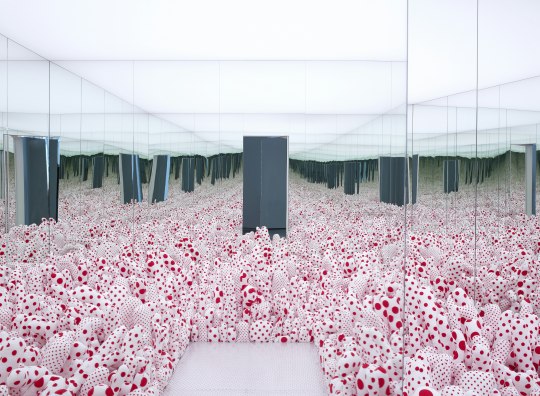
Phalli's Field (1965) - first mirrored room installation, filled with phallic shapes made out of fabric and cardboard, covered in polka dots.
From Stir World:
While the work circled back to the phallic motif, the design intervention of using mirrors created an architecture of infinite space. This was the beginning of what revolutionised her career so much so that in 2016, she was chosen as one of the world’s most influential people by TIME magazine. Since then, her exhibitions of infinity rooms like Love is Calling have had waiting lines of over five hours for a few seconds of viewing time.
Especially when Kusama combines polka dots with mirrored infinity rooms as she calls them, there is very much a sense of both reflectivity and reflexivity that happens. An interesting example in terms of this discussion, Infinity Mirrored Room - Love Forever (1966/1994), the polka dots in this room being represented by round, colored light bulbs:
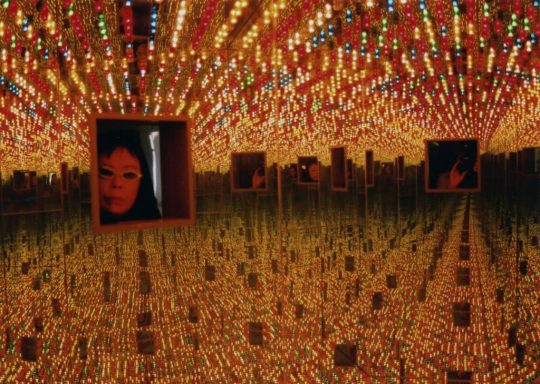
A description of the installation (emphasis mine):
Infinity Mirrored Room—Love Forever is an iteration of the second mirrored environment Kusama created. Sculptural, architectural, and performative, the installation blurs the lines between artistic disciplines and is activated by audience participation. Hexagonal in shape and mirrored on all sides, Love Forever features two peepholes that invite visitors to peer in and see both themselves and another participant repeated into infinity.
Kusama used her polka dots, especially when integrated into more phallic shapes in reflective rooms, to process and come to grips with her sexuality. And if there was an intentional reference being made to her art in Sydney's proclivity towards polka dots in season 3, I think it's in Carmy's coopting of the imagery in his sauce. The reflective and reflexive gesture indicates his observation of her (in that he noticed her repeating the pattern over the course of months in her clothes and scarves) as well as his desire for her. At their best, they are vibrantly collaborative and we see each of them let the other in more than anyone else. And this isn't entirely comfortable for Sydney, seen in the way she deflects his questions about her parents and her apartment at different points. But she does eventually tell him more and let him in more - and I think the polka dots could also be a representation of her coming to grips with her feelings and ultimately desire towards/for him, as well as the importance of their collaborative relationship, especially with the difficulty of Carmy in S3 as well as her offer from Shapiro.
(Also as an aside, Yayoi Kusama's art comes up as a rather regular inspiration/collaboration in food and fine dining, so it feels like her art may at least have been on someone's radar as they thought about Syd's polka dots this season. See here and here and here and here and here - as created by a former chef from the French Laundry.)
Sources for info and pictures:
Yayoi Kusama's website
Understanding Sexuality in Yayoi Kusama's Art
Accumulation (MoMA)
Wikipedia
The Alchemist of Polka Dots
Love Forever
#sydcarmy#polka dots#the bear season 3#yayoi kusama#polka dots in the bear#am I onto something? who knows#but it made my brain itch when I kept noticing Syd's polka dots#note: I am not an art historian#just a former english major who dabbled in art history courses once or twice#sydney x carmy#carmy x sydney
44 notes
·
View notes
Note
I love all the information on your blog! If you have a moment, would you confirm something? In every fanfic with Lilia he seems to use his bats to watch over others (particularly Silver) and can even use them to spy. (Basically, he's the bat master.) In the game does Lilia ever use bats for anything or are they just part of his aesthetic?

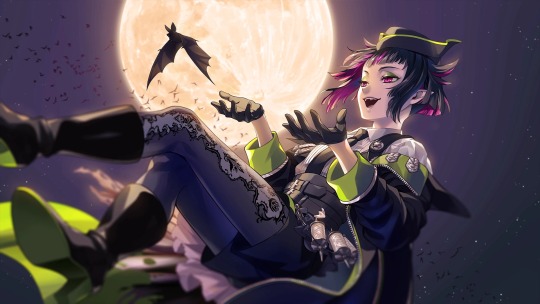
I checked all the Lilia content I could and (surprisingly) Lilia never mentions the bats or their relation to him in TWST canon. In fact, he never states that he has them do anything for him at all either. The fandom/fanon emphasizes the “bat” aspect + utility of Lilia far more than official content does, with fans often incorporating bats into his regular activities.
Lilia usually does tasks by himself in canon (even delivering Malleus’s holiday note to Yuu himself rather than relying on bats to do it). He doesn’t use bats to help spy on others either, even in situations when it would be a considerable boon (such as during the human-fae war, when having bats scout the area ahead for human soldiers would have been beneficial). This is consistent with other characters’ accounts as well. When Silver describes his childhood, he recalls that Lilia would go on globe trotting journeys and leave Silver alone in their cottage to look after the house and himself. Not once does Silver ever remark that bats watched over him in place of his father; it was either his woodland creature friends or the Zigvolt family that watched Silver in Lilia’s absence.
(Note: one scene that’s difficult to interpret due to the visual novel medium of TWST is when Yuu and co. meet General!Lilia in book 7; there is a part where a bunch of bats flood the screen, but it’s unclear whether they’re just wild animals of the forest or if they’re following Lilia’s command.)
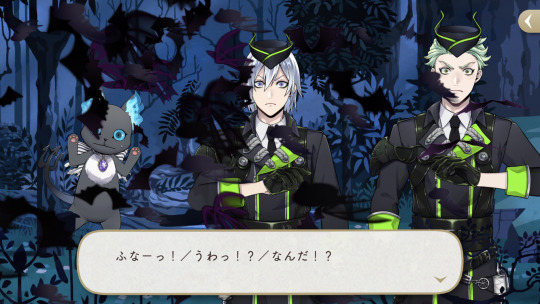
The only prominent time Lilia mentions bats is in his own Dorm Uniform vignettes, in which Silver and Sebek bring home an injured bat and Lilia nurses it back to health. Lilia demonstrates knowledge of bats, but nothing more beyond this (as he takes care of the injured one just as he would look after a human infant like Silver). At the end of the vignettes, Lilia prompts the bat to return to its family; he does not indicate if he is already familiar with the swarm of bats the recovered one is going to.
Bats are definitely a part of Lilia’s “aesthetic” though! He wears bat motifs in his clothes (such as on his Clubwear T-shirt and on Suitor Suit’s chain). Bats are also commonly included in his “image” artwork, such as his Birthday cards—and bats are even featured on Lilia’s character coffin design. They’re clearly a very important symbol for Lilia as a character.
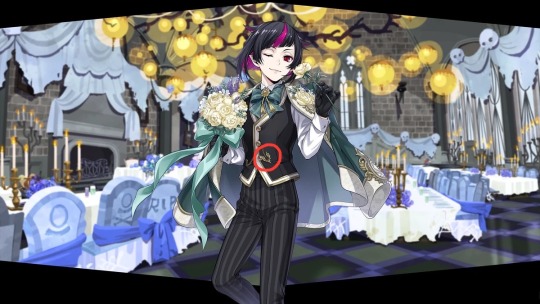
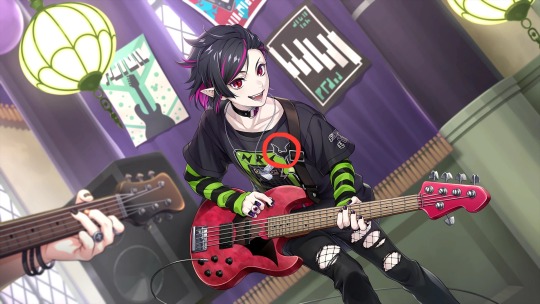
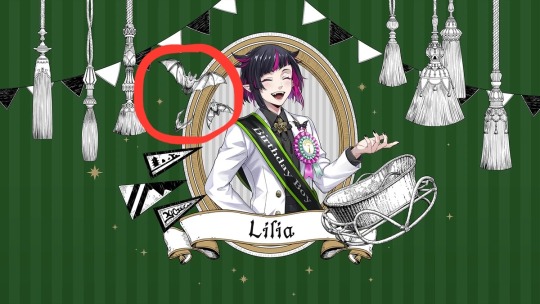
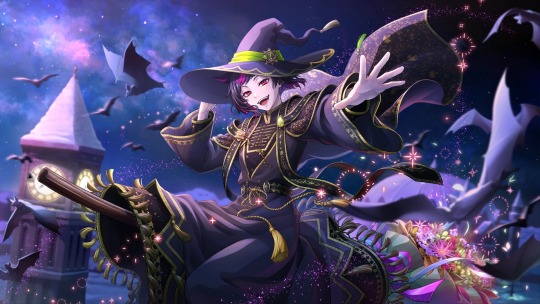

I think where the confusion (or headcanon?) comes from is that Lilia is seen with bats helping him in or appearing during lessons (the gameplay mechanic). Most notably, a swarm of bats holds Lilia’s broom for him in Flight Class. The bats also appear in other aspects of gameplay, such as Alchemy Class and in battles (although they aren’t shown actively “helping” Lilia in these instances; it’s more like the bats are just there).
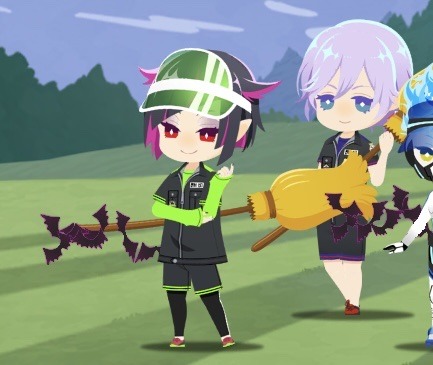


This probably led to fans speculating or assuming that Lilia has the ability to communicate with bats and can get them to do his bidding. (Isn’t it crazy what a few little animations can spark in a fandom? 😂) Part of this may also come down to the fact that Lilia himself is a nocturnal fae and displays many bat-like or vampiric tendencies himself, such as being averse to sunlight, staying up late/being nocturnal, greeting others while being upside down, and his preference for tomato/berry juice.
So! It’s just a “logical leap” to make, I guess 🦇
#twst#twisted wonderland#Lilia Vanrouge#disney twisted wonderland#notes from the writing raven#question#Yuu#Malleus Draconia#Sebek Zigvolt#Silver#Diasomnia
190 notes
·
View notes
Text
Gather round, everyone - today I'm going to talk about a topic I've never seen discussed anywhere: the use of lace in Madoka Magica, particularly Rebellion.
Earlier, I was examining sketches of some prototype designs from the Rebellion Production Note, particularly this glove with Homulilly's name on, and I noticed something interesting in the accompanying text.

"黒レース... kuro rēsu... black lace... Wait a minute. That fringe on the bottom of the glove is supposed to be lace??!!!!!!!"
Because I've seen this same "peacock's tail" motif a lot, actually--it's the outer ring on the mandalas that appear around Walpurgisnacht and Homulilly.




Here's a close-up shot of that last shot of Homulilly from the Rebellion Production Note, which has a much higher resolution than the finished film version, so you can really appreciate the details:

Take a look at the "peacock's tail" edges of the mandala and compare them to the lace of Homulilly's shawl. It's the same pattern. It's obvious once you know to look for it, but I never would have made the connection without Inu Curry's comment.
And this is interesting, because lace appears a lot in Rebellion and in surprising places.
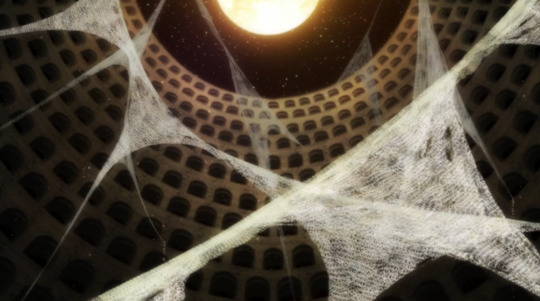
Take the "pennants" in this shot, for instance. I had always thought of them as "cobwebs", but then I saw the original sketch in the Rebellion Production Note--again, a much higher resolution than the film screenshot--and realized that they're woven lace, albeit a very different style from Homulilly's shawl.

There's also this striking image of Homura framed by lace that has always puzzled me, because what is it doing there (especially since it doesn't seem to be visible in any of the wide shots)?

I mentioned all of this to Silver, who said, "But wait, there's more!" and sent me screenshots to prove it.



As you can see, lace is associated with curtains, which are also an important visual motif in their own right. Not only does the fringe of Homulilly's glove in the Rebellion Production Note resemble curtains if you squint, the curtains that rise over Homulilly's entrance in the movie are also framed with lace and have the same overlapping "peacock's tail" shape.

Having established the connection between mandalas, lace, and curtains, let's take a look at the other witch who uses these in her design. Here's Walpurgisnacht's curtains from the opening shot of the original series.

Take a look at the lace at the center. You can see the same "peacock's tail" shape around the edges, and also what looks like a flower or a star or a sun at the center. Compare that with Walpurgisnacht's mandala that appears a few seconds later:

As you can see, both the "peacock's tail" and the flower/star at the center are both visible. (The ring in between is full of tomoe, which I have written about elsewhere, and the hole at the center bears an uncanny resemblance to the black hole at Homulilly's heart in the Production Note sketch above.)
In other words, the mandalas here are visual representations of lace patterns (or vice versa?). All of these elements are combined in the mandala of the Law of Cycles, which is literally a lace pattern with a similar flower/star design at the center:

Finally, there are multiple mandalas at the end of Rebellion featuring all kinds of different designs; this one has both the "peacock's tail" design and the central flower:

All of the mandalas in this scene are made of up of symbols that have appeared throughout Rebellion, most notably the dollhouse scene, although not in the same configurations. While they don't appear as physical lace, they certainly have lace-like patterns like the others.
(As an aside: I've always thought of the mandalas in the show as "doilies" in my head, and it turns out that impression wasn't so far off the mark. Life's funny like that.)
Mandalas are typically a symbol of divinity and world-creation, so it makes sense that Walpurgisnacht (the Stage-Producing witch) and the Law of Cycles (a goddess who has adopted many of Walpurgisnacht's attributes including a cart pulled by the witch's green elephants). Homulilly, too, creates a world inside her labyrinth, and is associated with sewing and thread and lace--and since mandalas and lace appear to be connected, it makes sense that she would have a mandala. Ditto for Devil Homura--who, I should take pains to point out, is also Homulilly (see the runes on the glove in the opening image)--as she has set herself up as the Law of Cycle's opposite.
So what does it all mean? First of all, I think this goes to show how much thought and care went into the creation of this series, and how even small details are connected to each other on a thematic and symbolic level. Secondly, it suggests yet another set of visual parallels between Walpurgisnacht and Homura/Homulilly, albeit on a much more subtle level than I was previously aware of.
Inu Curry, if you're reading this--I bet you thought that no one would ever notice and put the pieces together, but I did and now I'm telling the world. My since compliments, and I can't wait to see what you have in store for us in Walpurgis no Kaiten.
34 notes
·
View notes